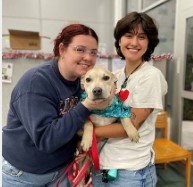January is Human Trafficking Prevention Month: Part 2 By: Justice Venture International [As we start the new…
[This month, we are highlighting Spay and Neuter Awareness Month with a three-part blog series written by our staff and a few of our close partners in the Dallas animal welfare space. The blog featured here is Part One. The Rees-Jones Foundation is grateful to work with organizations who are passionate about taking care of dogs and cats in Dallas. We believe when we care for companion animals, we will see families thrive in safer communities].
Overcapacity of Animal Shelters is a Human Problem
By Lynn Gibson, Senior Program Officer
As I write this, Dallas Animal Services (DAS) – the largest animal shelter in Dallas County – is over capacity. This is not an anomaly, but rather the daily reality for DAS, and the issue ranges from full to 150% overcapacity or more at times. This is not a criticism of DAS – unlike some shelters, DAS is required by statute to accept any animal that is brought to them.
At heart, this is a human problem. Only 10.9% of dogs and 7.7% of cats coming into DAS have been altered (sterilized or spayed or neutered). This leaves a whopping 89.1% of dogs and 92.3% of cats intact – meaning they can reproduce. And, reproduce they do at astronomical rates.
Cats generally begin to breed between four and six months of age and can have up to 4-5 litters a year. With each litter typically having 4-6 kittens, one female cat and her offspring can produce hundreds[1] to thousands or even tens of thousands of kittens in a very short time. While many free-roaming cats may fall victim to cars, disease, or predators, those that do not may have to survive in less-than-ideal or even dangerous conditions. Owned cats have a better prognosis for a long life, but if they are unaltered, they also contribute to the cat overpopulation problem.

Dogs also breed at prolific rates. A female dog can have two litters a year and around 10 litters during their life span. The larger the dog, the larger the number of puppies that is born to them. Smaller breeds may have 4-6 puppies per litter. Larger breeds can have 7 or more puppies per litter. This means that over a five-year period of time (assuming 2 litters a year, for five years), a small female dog could have anywhere between 37-55 puppies and larger animals could have anywhere from 65-92 puppies. This may not seem like a lot, but multiply that by the thousands of dogs we know remain unaltered in our community, and the population can grow out-of-control very quickly.
What this means for the citizens of Dallas: 1) Our largest city shelter is faced with the unenviable position of having to euthanize one of every five dogs that enter the shelter, largely due to space constraints. 2) Dogs, particularly large dogs, are at the highest risk of euthanasia due to the lack of adopters and the ability to transfer these animals elsewhere. Large dogs also reproduce more rapidly than smaller dogs.
Dallas Animal Services, and dozens of heroic shelters, animal welfare agencies, and rescue and transfer groups, work tirelessly, and often with little or no pay to help animals in our community. While this ensures positive outcomes (adoption, transport to northern communities, etc.) for many animals, the reality is there are still too many animals being born (and abandoned or neglected in our community).
 Spaying and neutering is THE solution to the problem. It is evident that all dogs and cats in our city must be spayed or neutered if families in our communities are going to thrive. The safety and wellbeing of our neighbors depends on a healthy population of companion animals. We are grateful for partners who provide a plethora of resources for anyone in the city to spay or neuter their pet.
Spaying and neutering is THE solution to the problem. It is evident that all dogs and cats in our city must be spayed or neutered if families in our communities are going to thrive. The safety and wellbeing of our neighbors depends on a healthy population of companion animals. We are grateful for partners who provide a plethora of resources for anyone in the city to spay or neuter their pet.
As of February 1, DAS and Spay Neuter Network (SNN) have joined forces to provide free spay/neuter services for Dallas-area free-roaming cats. SNN executive director Jordan Craig writes “SNN, is committed to helping reduce pet overpopulation, and this includes free-roaming cats in our community. SNN and DAS are working together to make these services more accessible.” The agency’s mission is to eliminate pet overpopulation through spay/neuter, while empowering communities to care responsibly for dogs and cats.
For more information on where you can access help for animals, head to Spay Neuter Network, Dallas Animal Services or call 311 for assistance.
*Check back for Part Two of this blog series soon.
[1] Reproductive capacity of free-roaming domestic cats and kitten survival rate
Felicia B Nutter 1, Jay F Levine, Michael K Stoskopf; • DOI: 10.2460/javma.2004.225.1399
Share this post:
Category: Uncategorized
January is Human Trafficking Prevention Month: Part 1 By Shellie Velasco, Program Officer [As we start the…
Welcome to 2025 By Adrian Cook, Director of Research & Evaluation “But the steadfast love of the…

